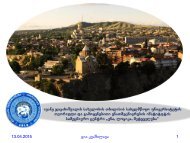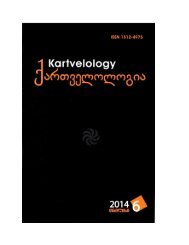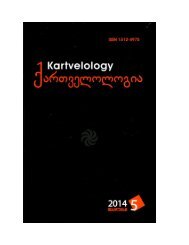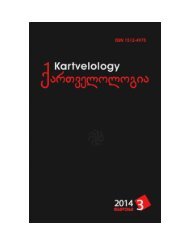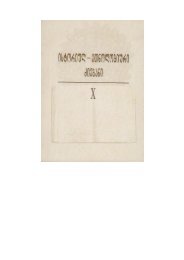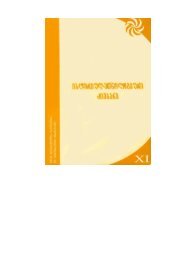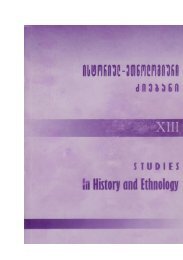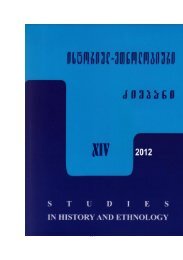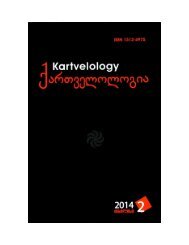Kvashilava, Gia, 2010. On Reading Pictorial Signs of the Phaistos Disk and Related Scripts (2). Rosette (in Georgian and English)
This study concerns the graphic character, symbolic meanings, typological parallels, commentaries and reading of the Phaistos Disk pictorial sign PHD38.
This study concerns the graphic character, symbolic meanings, typological parallels, commentaries and reading of the Phaistos Disk pictorial sign PHD38.
Create successful ePaper yourself
Turn your PDF publications into a flip-book with our unique Google optimized e-Paper software.
In Psalms (84.11) we read: ‘<strong>the</strong> Lord God is a sun <strong>and</strong> a<br />
shield’. The philosophers <strong>of</strong> <strong>the</strong> classical period characterized<br />
<strong>the</strong> sun variously. E.g. Aeschylus says that „<strong>the</strong> sun is a circle‟;<br />
Plutarch – that „<strong>the</strong> sun is a sphere‟; Pythagoras <strong>of</strong> Samos –<br />
that „<strong>the</strong> sun is a disk‟. O<strong>the</strong>rs compared: it with „a beautiful<br />
woman‟, „a shield‟; or said: „<strong>the</strong> sun is a wheel‟, „<strong>the</strong> sun is an<br />
eye‟, <strong>and</strong> „eye is light‟, etc.<br />
In various cultures <strong>the</strong> symbols <strong>of</strong> <strong>the</strong> Sun-god are: an eightpetalled<br />
rosette 1 (Neve 1996, 33, 60; Herder 1980, 134); a<br />
disk with an eight-petalled rosette (Herder 1980, 130); a<br />
disk 2 (Maxwell-Hyslop 1971, 149; Mijatović, N<strong>in</strong>ković,<br />
Vemić 2003, 338, 340, 341; Kurtik 1999, 508 21 ; Kazmierczak<br />
1992, 8, Fig. 18); an eye (Nadiradze 1989, 21, 22); a circle<br />
with a dot at its centre (Kasak, Veede 2001, 29, 30; Collier,<br />
Manley 2007, 136; EA 1987, 557; Kazmierczak 1992, 24, Fig.<br />
91); w<strong>in</strong>ged disks with an eight-petalled rosette ,<br />
(comp. Black, Green 1992); w<strong>in</strong>ged disks ,<br />
(Neve 1996, 57, 58, 59; Heiser 2006, 10); a w<strong>in</strong>ged disk with<br />
snakes ; a circle with a cross (Evans 1909, 87;<br />
Kazmierczak 1992, 10, Fig. 25; Bauer, Dümotz, Golow<strong>in</strong> 1987,<br />
1 . Accord<strong>in</strong>g to <strong>the</strong> lexicon <strong>of</strong> S.-S. Orbeliani (1698; 1991, 26; 1993, 335,<br />
336): “where this [eight-petalled rosette ] sits, is <strong>the</strong> sun”.<br />
2 . Comp.: Tibetan [ ] <strong>and</strong> Sanskrit [ ] mean<br />
a disk, r<strong>in</strong>g, sphere <strong>and</strong> wheel (Ch<strong>and</strong>ra Das 1989, 56; Conway 2006, 1;<br />
MPW 1992, II, 100); <strong>the</strong>y are symbols <strong>of</strong> <strong>the</strong> sun (Conway 2006, 2).<br />
Correspond<strong>in</strong>g Aztec symbol is a disk <strong>of</strong> <strong>the</strong> Sun-god, Tonatiuh (comp.:<br />
Galich 1990, 109, 110; MPW 1992, II, 518). In H<strong>in</strong>duism a wheel is a<br />
symbol <strong>of</strong> <strong>the</strong> solar deity, Surya (Devanagari [ ] – <strong>the</strong> supreme<br />
light) (Gamkrelidze, Ivanov 1984, II, 684, 684 1 , 720, 721; comp. MPW 1992,<br />
II, 477, 478).<br />
252




